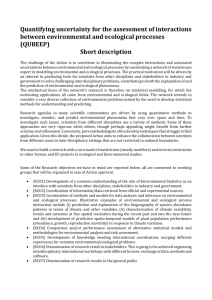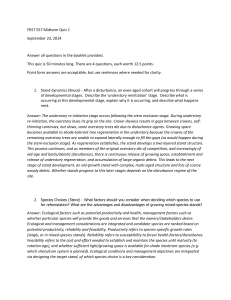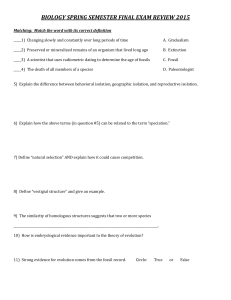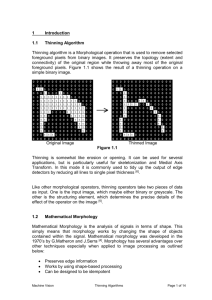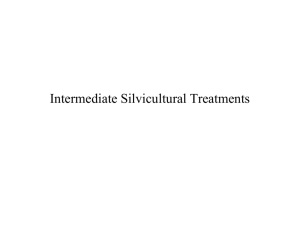Standards for management - Ecological thinning of eucalypts
advertisement
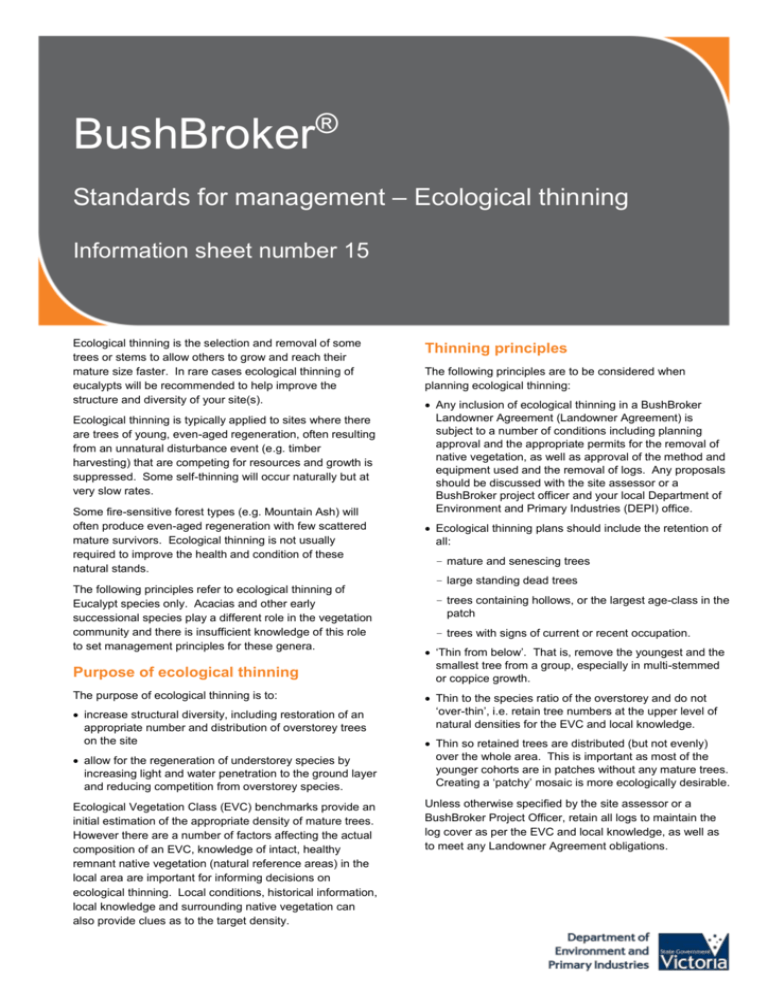
BushBroker® Standards for management – Ecological thinning Information sheet number 15 Ecological thinning is the selection and removal of some trees or stems to allow others to grow and reach their mature size faster. In rare cases ecological thinning of eucalypts will be recommended to help improve the structure and diversity of your site(s). Ecological thinning is typically applied to sites where there are trees of young, even-aged regeneration, often resulting from an unnatural disturbance event (e.g. timber harvesting) that are competing for resources and growth is suppressed. Some self-thinning will occur naturally but at very slow rates. Some fire-sensitive forest types (e.g. Mountain Ash) will often produce even-aged regeneration with few scattered mature survivors. Ecological thinning is not usually required to improve the health and condition of these natural stands. The following principles refer to ecological thinning of Eucalypt species only. Acacias and other early successional species play a different role in the vegetation community and there is insufficient knowledge of this role to set management principles for these genera. Purpose of ecological thinning The purpose of ecological thinning is to: increase structural diversity, including restoration of an appropriate number and distribution of overstorey trees on the site allow for the regeneration of understorey species by increasing light and water penetration to the ground layer and reducing competition from overstorey species. Ecological Vegetation Class (EVC) benchmarks provide an initial estimation of the appropriate density of mature trees. However there are a number of factors affecting the actual composition of an EVC, knowledge of intact, healthy remnant native vegetation (natural reference areas) in the local area are important for informing decisions on ecological thinning. Local conditions, historical information, local knowledge and surrounding native vegetation can also provide clues as to the target density. Thinning principles The following principles are to be considered when planning ecological thinning: Any inclusion of ecological thinning in a BushBroker Landowner Agreement (Landowner Agreement) is subject to a number of conditions including planning approval and the appropriate permits for the removal of native vegetation, as well as approval of the method and equipment used and the removal of logs. Any proposals should be discussed with the site assessor or a BushBroker project officer and your local Department of Environment and Primary Industries (DEPI) office. Ecological thinning plans should include the retention of all: – mature and senescing trees – large standing dead trees – trees containing hollows, or the largest age-class in the patch – trees with signs of current or recent occupation. ‘Thin from below’. That is, remove the youngest and the smallest tree from a group, especially in multi-stemmed or coppice growth. Thin to the species ratio of the overstorey and do not ‘over-thin’, i.e. retain tree numbers at the upper level of natural densities for the EVC and local knowledge. Thin so retained trees are distributed (but not evenly) over the whole area. This is important as most of the younger cohorts are in patches without any mature trees. Creating a ‘patchy’ mosaic is more ecologically desirable. Unless otherwise specified by the site assessor or a BushBroker Project Officer, retain all logs to maintain the log cover as per the EVC and local knowledge, as well as to meet any Landowner Agreement obligations. Ecological thinning Health and safety You are responsible for ensuring all works required in implementing the management actions are conducted in a safe manner and comply with the lawful requirements of any Authority, and with all Acts, regulations and other laws which may be applicable to the Landowner Agreement. To determine whether there are any underground pipes or cables on your property, you may wish to consider calling 1100 - “Dial before you dig”. This is a free referral service from anywhere in Australia. Further information For further information on BushBroker, please contact the Department of Environment and Primary Industries Customer Service Centre on 136 186 or visit the DEPI website at: www.depi.vic.gov.au/bushbroker. All BushBroker Information Sheets are available on the website. Published by the Victorian Government Department of Environment and Primary Industries Melbourne, October 2013 © The State of Victoria Department of Environment and Primary Industries Melbourne 2013 This publication is copyright. No part may be reproduced by any process except in accordance with the provisions of the Copyright Act 1968. Accessibility If you would like to receive this publication in an alternative format, please telephone DEPI Customer Service Centre 136 186, email customer.service@depi.vic.gov.au (or relevant address), via the National Relay Service on 133 677 www.relayservice.com.au This document is also available in on the internet at www.depi.vic.gov.au Disclaimer ISBN 978-1-74287-692-4 (online – set) www.depi.vic.gov.au This publication may be of assistance to you but the State of Victoria and its employees do not guarantee that the publication is without flaw of any kind or is wholly appropriate for your particular purposes and therefore disclaims all liability for any error, loss or other consequence which may arise from you relying on any information in this publication.






